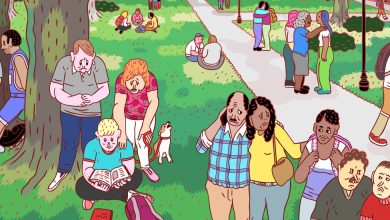The Timeline We’re on Is Even Darker Than ‘The Matrix’ Envisioned

When “The Matrix”was released in 1999, hype about the internet had reached a frenzy. Time Magazine had named a young Jeff Bezos Person of the Year, for embodying the two great themes of the year, “e-commerce and dotcom mania.” The BBC declared it “the year of the internet.” In The New York Times, Thomas Friedman described the web as “a symbol that we are all connected but nobody is in charge.”
Some excitedly heralded “The Matrix,” with its pioneering computer-generated special effects and cyberpunk motif, as “the first movie of the 21st century.” And over 20 years after its release, the filmpersists as perhaps the definitive movie of the early internet age. Its influence is everywhere, animating fashion and philosophy, as well as our technological fears and fantasies. Its iconography — from the “red pill,” which helps to awaken characters to the reality of their dystopian circumstances, to “the endless allure of Keanu Reeves’ sunglasses,” as GQ put it — are cultural mainstays. The film spawned two sequels, both released in 2003, and with “The Matrix Resurrections,” a fourth film, released Wednesday, the franchise returns to a digitized world that it has played no small part in shaping.
Given how the internet has panned out, however, it’s not an entirely happy accolade. We are in a very dark timeline — one in which the Tesla and SpaceX chief executive Elon Musk could tell his 34 million Twitter followers to “take the red pill,” a concept increasingly co-opted by alt-right conspiracists, and the former first daughter Ivanka Trump can reply: “Taken!” (Lilly Wachowski, “The Matrix” co-director, was unimpressed by this exchange.) After Facebook’s Mark Zuckerberg announced his dreary plans for a “metaverse,” a Matrix-like “embodied internet, where instead of just viewing content, you are in it,” the film franchise’s marketing team responded by tweeting a new tagline for “The Matrix Resurrections”: “Now based on real events.”
Yet in some ways, even the original “Matrix” film and its two sequels imagined a future more hopeful than the one conjured up by Silicon Valley today. On the surface, the movies presented a straightforward dystopia: a bleak world where, sometime in the late 22nd century, humans are harvested in vast fields as an abundant energy resource to fuel machine overlords. The machines have plugged humans into a simulation of the year 1999, known as the Matrix, which keeps them passive and distracted, unaware of their predicament.
So far, so depressing. Yet alongside this dark tableau, “The Matrix” also contained dreams of a better internet than our own. The eponymous computer simulation is a sinister mechanism of control, imposed upon humans to harness their energy. But after the simulation is seen as a construction (enabled by swallowing the “red pill”), people have the power to plug back in and traverse it as a truer version of themselves.
This is where a sense of nostalgia haunts a rewatching of “The Matrix”: not for the 1999 it depicts, but for the future — and the internet — it suggested could exist. It’s “a world without rules and controls, without borders or boundaries, a world where anything is possible,” Neo (the main character, played by Mr. Reeves) declares at the end of the first film.
Dominated by a handful of mega-corporations, today’s digital sphere seems more in line with the machines’ coercive operation than the dreams of Neo and his band of rebels. The internet now stands as a vast web designed to capture our tastes, attention and patterns of thought, and to push them along profit-making lines. The goal is not a world where anything is possible — but a world where everything is predictable and purchasable.
The promise of digital self-realization that made “The Matrix” no ordinary dystopia was integral to the utopianism of the early internet. An early online user, quoted by the sociologist and clinical psychologist Sherry Turkle in 1995, declared that, on the internet, “you can be whoever you want to be … whoever you have the capacity to be … You don’t have to worry about the slots other people put you in.” Or, as a famous New Yorker cartoon playfully put it around the same time, showing a dog typing away at a computer, “On the internet, nobody knows you’re a dog.”
The diverse cast of “The Matrix” suggests an internet that has freed humanity from discrimination based on race, class and gender. Neo starts out as Thomas Anderson, a bored software engineer who hates his job (working for a company called, somewhat forebodingly, “Meta-cortex”), before he becomes a kung fu master who can dodge bullets. A fellow superhacker, his lookalike lover, Trinity, (played by Carrie-Anne Moss), persistently defies both gravity and the gendered expectations of her enemies. “The Matrix cannot tell you who you are,” she tells him. (Another character, Switch, was originally intended by the directors to be gender fluid: a man in the real world and a woman in the simulation.)
But the internet today does tell you who you are, and it’s hardly a place free from prejudice. Silicon Valley’s prevailing ethos has moved away from the idea that the internet can be a space to live outside society’s demands and expectations. At Facebook, Mr. Zuckerberg, for example, has argued that having a second identity is “an example of a lack of integrity,” and the social media company’s policy explains that “Facebook is a community where everyone uses the name they go by in everyday life … so that you always know who you’re connecting with.” Such strictures recall the main villain of “The Matrix,” Agent Smith, a corporate apparatchik working on behalf of the machines, who insists on calling Neo by his original name. “It seems that you have been living two lives,” Smith chides in the first film, after arresting Neo. “One of these lives has a future. One of them does not.”
Despite the pseudonyms, trolls and alter egos that still dwell in some corners of the internet, its main byways now prize consistency and transparency over the risks of anonymity and reinvention. The idea of the internet as a place to cultivate an identity outside the slots other people put you in has been eclipsed by a social media-driven focus on creating an aspirational personal brand. Self-realization is now measured in likes, shares and follower counts.
“Our digital presentations are slicker, influencer-influenced,” Ms. Turkle, a professor of the social studies of science and technology at MIT, told me. “Everyone wants to present themselves in their best light, but now we have a corporate filter of what ‘pleases.’”
The cultural shift toward holding one narrowly defined identity — online and offline, across platforms — aligns neatly with Silicon Valley’s interests. The aim of many tech companies is to know us more intimately than we know ourselves, to predict our desires and anxieties — all the better to sell us stuff. The presumption that we each hold a single “authentic” identity simplifies the task, suggesting to advertisers that we are consistent, predictable consumers.
The tech theorist Mark Andrejic, author of “Automating Media,” has used a provocative term for this mode of capitalism: “umbilicular commerce.” Just as an umbilical cord provides for a fetus’s needs before it can communicate them, so too do tech platforms strive to sate our desires before we have expressed them. Mr. Zuckerberg has said he wants to find “a fundamental mathematical law” that “governs the balance of who and what we all care about.” And Amazon’s predictive algorithm for what it calls “anticipatory shipping” uses artificial intelligence to predict what you’ll order and stock it in a warehouse near you, for same-day delivery.This is a vision where the internet amounts to little more than a big, mind-reading “vending machine,” providing products the moment you think of them, or earlier.
Mr. Andrejic’s term has an eerie resonance with “The Matrix,” where humans are grown in womb-like pods and then plugged into the simulation through umbilical-like cords. (The title comes from both an early term for the internet and a Latin word for “womb.”) The set-up suggests our infantilization, a future where all our desires are fulfilled in advance yet agency has ceased to exist, where the darker facts of our digital existence — the alternative interests at its center — are concealed from us. It is a future very like our own.
As “The Matrix” franchise returns, the optimism around the internet in 1999 feels very far away. In our age of climate breakdown and extreme inequality, the hours we while away online are increasingly shadowed by an awareness that, like humans plugged into the Matrix, we perpetuate a system that does not have humanity’s best interests at its heart, a system that may in fact be working actively against us.
At least in “The Matrix,” humans have machines to blame. We have only ourselves, and the internet we have made.
Samuel Earle (@swajcmanearle) is a British journalist who writes on politics and culture. His first book,”Tory Nation,” about how the Conservatives’ election winning machine has dominated British reality for almost two centuries, will be out in early 2023.
The Times is committed to publishing a diversity of letters to the editor. We’d like to hear what you think about this or any of our articles. Here are some tips. And here’s our email: [email protected].
Follow The New York Times Opinion section on Facebook, Twitter (@NYTopinion) and Instagram.





